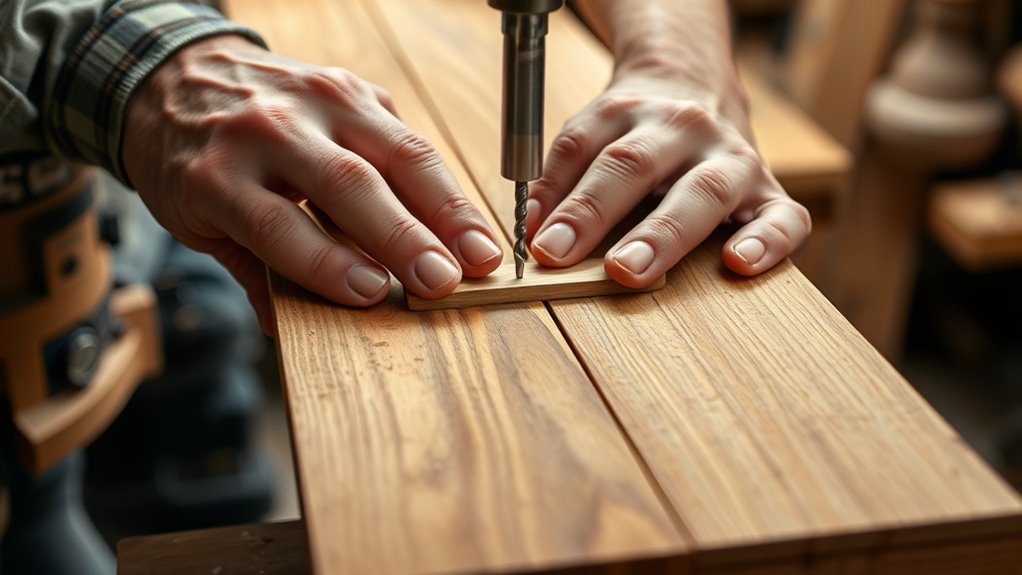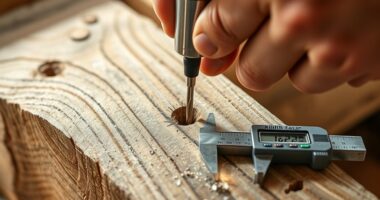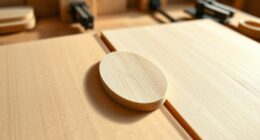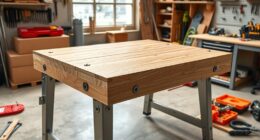To align and drill for hidden fasteners, start by carefully measuring and marking your joints to guarantee proper alignment. Use a doweling jig for precise guidance, making sure your drill bits follow the grain direction for maximum strength and aesthetics. Keep drill depths consistent and the fit snug but not tight. Attention to detail during this process is key to creating strong, seamless joints that look professional—continue to explore more tips for perfecting your doweling techniques.
Key Takeaways
- Use a doweling jig to ensure precise alignment of drill holes for strong, hidden joints.
- Mark drilling points carefully, matching grain direction to maximize joint strength and appearance.
- Drill holes perpendicular to the wood grain to prevent weakening or cracking of the joint.
- Keep drill bits and dowels snug but not tight to achieve a flush, seamless finish.
- Verify hole alignment and depth before inserting dowels for secure, hidden fasteners.
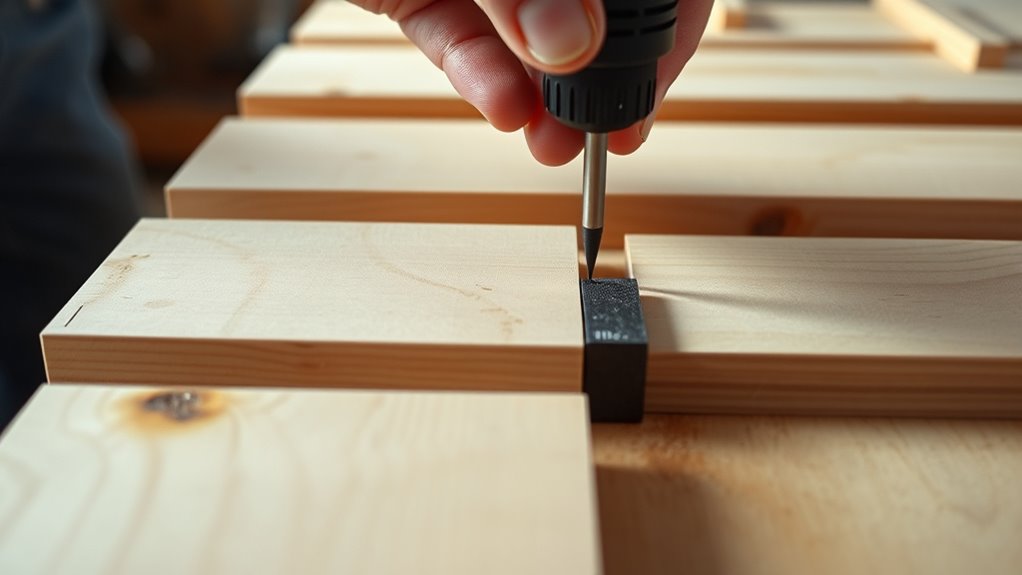
Doweling is a woodworking technique that involves inserting wooden dowels—small cylindrical rods—into holes to join two pieces of wood securely. This method is highly valued in woodworking because it creates strong, precise joints without relying on visible fasteners like screws or nails. When you’re working on projects where aesthetics matter, doweling offers a clean, professional finish, as the fasteners remain hidden inside the wood. To achieve this, you need to understand key joinery techniques that guarantee proper alignment and strength. Properly drilled holes must be aligned perfectly to avoid misfits or weak joints, which is why understanding how to use dowels correctly is crucial.
Doweling creates strong, hidden joints for a clean, professional woodworking finish.
One of the most critical aspects of successful doweling is paying attention to the wood grain. The wood grain affects both the strength and appearance of your joints. When drilling holes for dowels, you want to align your holes along the same direction as the grain to maximize holding power and minimize the risk of splitting the wood. If you drill perpendicular or at odd angles to the grain, you might weaken the joint or cause the wood to crack. Additionally, matching the grain pattern ensures a seamless look, especially when you’re joining visible edges or surfaces. When selecting your wood, consider the grain direction to optimize both the joint’s durability and aesthetic appeal. Choosing the right type of wood, such as hardwoods like oak or maple, can also enhance the joint’s strength and longevity.
Precision is key when using dowels, especially since the goal is to hide the fasteners completely. To do this effectively, you should mark your drilling points carefully, ensuring they are centered and aligned correctly. Using a doweling jig can considerably improve your accuracy, as it guides your drill bit to the correct spots and angles. This step helps maintain consistent spacing and depth, which is essential for a tight fit. Remember, the fit should be snug but not overly tight, as forcing the dowels into a tight hole can cause splitting or damage to the wood. When you insert the dowels, apply gentle pressure and ensure they are flush with the surface for a clean look.
Finally, the process of drilling and inserting dowels is straightforward but demands attention to detail. Take your time to measure carefully, align your drill bits properly, and match the grain for both strength and appearance. By mastering these joinery techniques, you’ll create durable, hidden joints that enhance the beauty and integrity of your woodworking projects. Whether you’re building furniture or small crafts, proper doweling elevates your craftsmanship and results in a professional finish that’s both strong and attractive.
Frequently Asked Questions
What Types of Wood Are Best for Doweling Projects?
You should choose hardwoods like oak, maple, or cherry for doweling projects, as they have stable grain directions and low moisture content, which helps prevent splitting. Softwoods like pine or cedar work well too, but guarantee your wood has consistent grain direction and isn’t overly moist. Properly drying and selecting wood with aligned grain will give you stronger, more precise joints, making your project durable and professional-looking.
How Do I Choose the Right Drill Bit Size?
Choosing the right drill bit size is essential; don’t just guess, aim for precision. Measure the dowel’s diameter and select a bit that matches or is slightly smaller for a snug fit. This guarantees your drill bit accuracy, leading to stronger dowel joints. Remember, a tight fit is like a handshake—it’s the key to lasting strength. When in doubt, test on scrap wood before drilling your final piece.
Can Doweling Be Used for Heavy Load Furniture?
Yes, doweling can be used for heavy load furniture, but you need to take into account joint strength and proper technique. Use thicker dowels and ensure precise alignment to maximize load-bearing capacity. For extra strength, consider adding reinforcement like glue or metal fasteners. Properly sized dowels and strong joints are essential to handle heavy loads safely, so don’t skimp on quality or installation accuracy.
How Do I Prevent Wood Splitting When Drilling?
To prevent wood splitting when drilling, pay attention to wood grain orientation and control your drill speed. Always drill perpendicular to the grain, reducing the risk of splitting. Use a slower drill speed, especially near edges, to minimize stress. Additionally, consider using a backing piece of scrap wood to support the workpiece, which helps distribute pressure evenly and prevents splitting during the drilling process.
What Are Common Mistakes to Avoid in Doweling?
You should avoid rushing the process, as it can lead to misaligned joints and weak connections. Always guarantee proper glue application, spreading it evenly to prevent gaps. Double-check your joint alignment before drilling to ensure accuracy. Using the right drill bit size helps prevent wood splitting. Also, don’t force dowels; if they don’t fit snugly, adjust your measurements. These steps help create strong, clean dowel joints.
Conclusion
Now that you’ve mastered doweling, you’re basically a woodworking wizard! With perfect alignments and flawless hidden fasteners, your projects will stand taller than Mount Everest—literally! No more crooked joints or unsightly screws ruining your masterpiece. You’ve discovered the secret to professional-quality furniture that’ll make everyone think you’ve got a magic touch. Keep practicing, and soon, your woodworking skills will be so legendary, even the carpenters of the ages will bow in awe!
